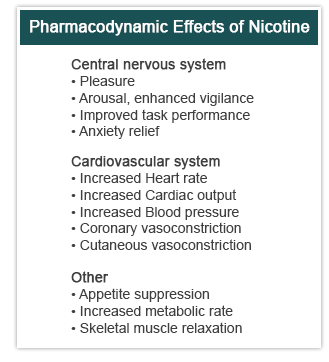|
Nicotine pharmacodynamics refers to the effects that nicotine has on the body.
It’s not known whether the improvements in mood or task performance are due to relief of nicotine withdrawal symptoms or a direct effect of nicotine on the brain. Pharmacodynamic effects of nicotine on the cardiovascular system include increased heart rate, cardiac output, and blood pressure as well as cutaneous and coronary vasoconstriction. After a cigarette is smoked, the smoker’s blood pressure rises by 5–10 mmHg for 15–30 minutes, and the heart rate increases an average of 10–20 beats/min for up to 60 minutes. Studies suggest that there is a flat dose-response to the cardiovascular effects of nicotine. This so-called “ceiling effect” might be due to a rapid but partial development of tolerance to the cardiovascular effects of nicotine. Other pharmacodynamic effects of nicotine include its appetite suppressant effect and modest acute increases in the metabolic rate. Most people who quit using tobacco will gain weight, although the average person will gain less than 10 pounds. Nicotine also causes relaxation of some skeletal muscle.
|
|||
|
|
|||
 This slide lists the key pharmacodynamic effects of nicotine on the central nervous system. Specifically, nicotine leads to:
This slide lists the key pharmacodynamic effects of nicotine on the central nervous system. Specifically, nicotine leads to: